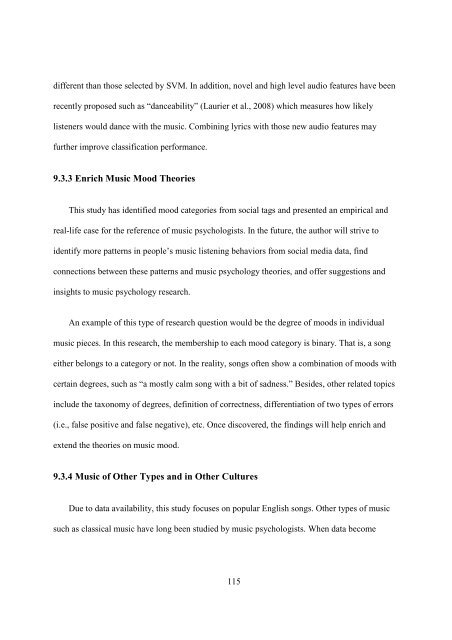improving music mood classification using lyrics, audio and social tags
improving music mood classification using lyrics, audio and social tags
improving music mood classification using lyrics, audio and social tags
You also want an ePaper? Increase the reach of your titles
YUMPU automatically turns print PDFs into web optimized ePapers that Google loves.
different than those selected by SVM. In addition, novel <strong>and</strong> high level <strong>audio</strong> features have been<br />
recently proposed such as “danceability” (Laurier et al., 2008) which measures how likely<br />
listeners would dance with the <strong>music</strong>. Combining <strong>lyrics</strong> with those new <strong>audio</strong> features may<br />
further improve <strong>classification</strong> performance.<br />
9.3.3 Enrich Music Mood Theories<br />
This study has identified <strong>mood</strong> categories from <strong>social</strong> <strong>tags</strong> <strong>and</strong> presented an empirical <strong>and</strong><br />
real-life case for the reference of <strong>music</strong> psychologists. In the future, the author will strive to<br />
identify more patterns in people’s <strong>music</strong> listening behaviors from <strong>social</strong> media data, find<br />
connections between these patterns <strong>and</strong> <strong>music</strong> psychology theories, <strong>and</strong> offer suggestions <strong>and</strong><br />
insights to <strong>music</strong> psychology research.<br />
An example of this type of research question would be the degree of <strong>mood</strong>s in individual<br />
<strong>music</strong> pieces. In this research, the membership to each <strong>mood</strong> category is binary. That is, a song<br />
either belongs to a category or not. In the reality, songs often show a combination of <strong>mood</strong>s with<br />
certain degrees, such as “a mostly calm song with a bit of sadness.” Besides, other related topics<br />
include the taxonomy of degrees, definition of correctness, differentiation of two types of errors<br />
(i.e., false positive <strong>and</strong> false negative), etc. Once discovered, the findings will help enrich <strong>and</strong><br />
extend the theories on <strong>music</strong> <strong>mood</strong>.<br />
9.3.4 Music of Other Types <strong>and</strong> in Other Cultures<br />
Due to data availability, this study focuses on popular English songs. Other types of <strong>music</strong><br />
such as classical <strong>music</strong> have long been studied by <strong>music</strong> psychologists. When data become<br />
115
















